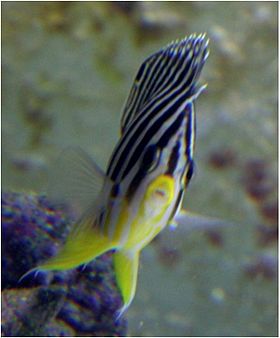- Centropyge multifasciata
-
Barred Angelfish 
Scientific classification Kingdom: Animalia Phylum: Chordata Class: Actinopterygii Order: Perciformes Family: Pomacanthidae Genus: Centropyge Species: C. multifasciata Binomial name Centropyge multifasciata
(Smith & Radcliffe, 1911)Synonyms Holacanthus multifasciatus
Smith & Radcliffe, 1911
Paracentropyge multifasciata
Smith & Radcliffe, 1911The barred angelfish or multibarred angelfish (Centropyge multifasciata) is a species of marine angelfish (family Pomacanthidae) of the order Perciformes. It is native to the Indo-Pacific, more specifically an area from the Cocos-Keeling Atoll to the Society Islands, ranging north to the Yaeyama Islands and south to the Great Barrier Reef. C. multifasciata is one of three deeper-bodied species of dwarf angels (the other species include ocellus on their dorsal fin that fades when they grow.[1] It inhabits caves and crevices in outer reef slopes and can be found in depths between 20m and 70m. C. multifasciata feeds on algae, sponges, tunicates and other benthic invertebrates and small crustaceans and can often be seen foraging upside-down on cave ceilings.
Centropyge multifasciata lives in harems with one dominant male and usually multiple females. Like all other Centropyge angels it is a protogynous hermaphrodite, with all individuals being female initially and the dominant ones changing to males. Barred angelfish are broadcast spawners, releasing their gametes into the water column after an intense and lengthy mating ritual. They show no parental care. The larvae hatch after 16-18 hours from the small eggs (0.7mm in diameter). They have a pelagic phase of up to 50 days[2] after which they become benthic and metamorphose into juveniles.
In the aquarium
Centropyge multifasciata is one of the medium priced dwarf angelfish with sales prices usually ranging from $50 to $100 per specimen (2010). Availability may vary but C. multifasciata cannot be considered "rare" in the trade. They usually arrive in fish stores in good health, problems can however arise when keeping them in sterile quarantine settings without live rock where not enough food can be found, as barred angelfish often do not accept artificial or frozen foods initially. Aquarists will therefore have to weigh the risks of skipping quarantine. Applying freshwater dips before placing C. multifasciata in their tanks is usually sufficient to prevent the introduction of protozoans via these fish.
Barred angelfish are social fish and should be kept in pairs or larger groups in large enough reef tank settings. Keeping more than one specimen also facilitates weaning them onto frozen or prepared foods (pelleted fish food or flakes, Artemia, Mysis, mussels and fresh oysters). After introduction to the tank C. multifasciata can be quite shy and reclusive, but when they have established their territory this will almost always improve. Outgoing but not too aggressive tank mates, such as for example surgeonfish or butterflyfish can help with overcoming timidness. When keeping barred angelfish with other species of the genus Centropyge, the different levels of aggressiveness of the different species have to be taken into account, as C. multifasciata is one of the less aggressive members of the genus.[1]
References
- ^ a b http://www.wetwebmedia.com/ca/volume_6/volume_6_2/multifasciata.htm
- ^ http://www.rcthawaii.com/angel/5.htm
- Froese, Rainer, and Daniel Pauly, eds. (2008). "Centropyge multifasciata" in FishBase. December 2008 version.
Categories:
Wikimedia Foundation. 2010.
